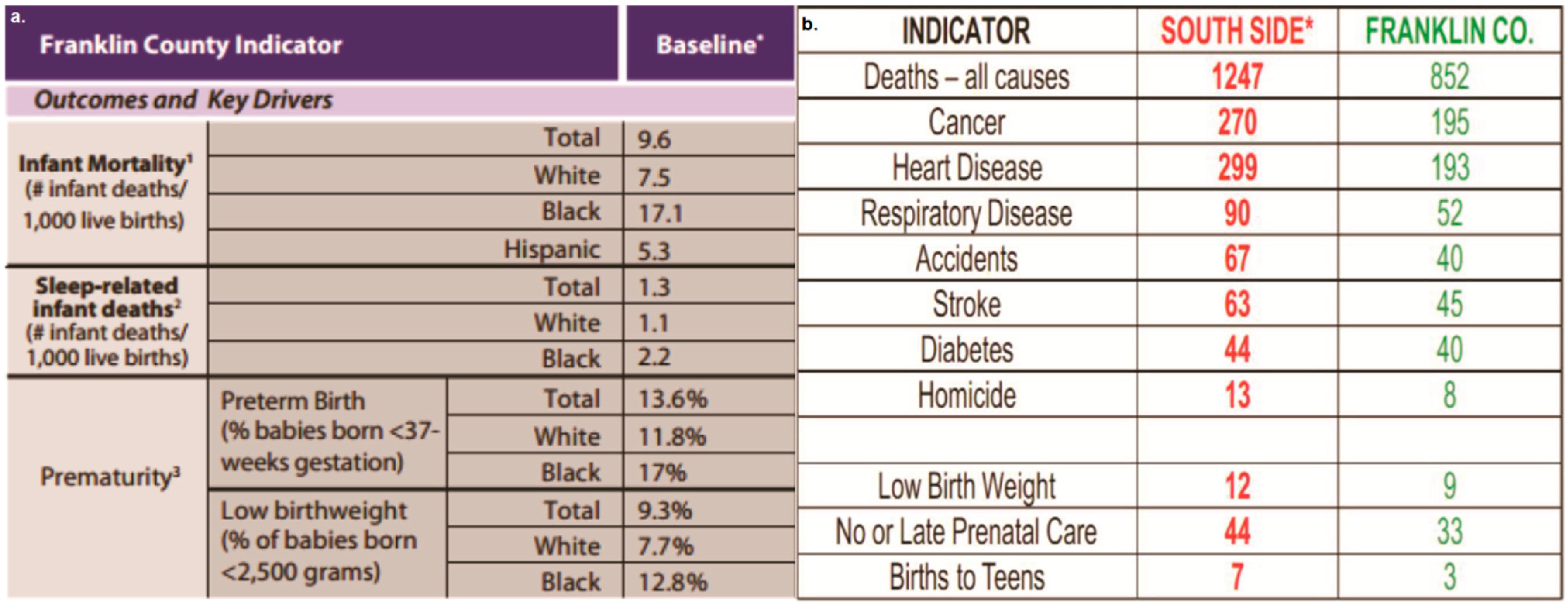Application of Citizen Science Risk Communication Tools in a Vulnerable Urban Community
Abstract
:1. Introduction
Environmental Health Disparities
2. Materials and Methods
2.1. Community Mapping Decision Support Tools
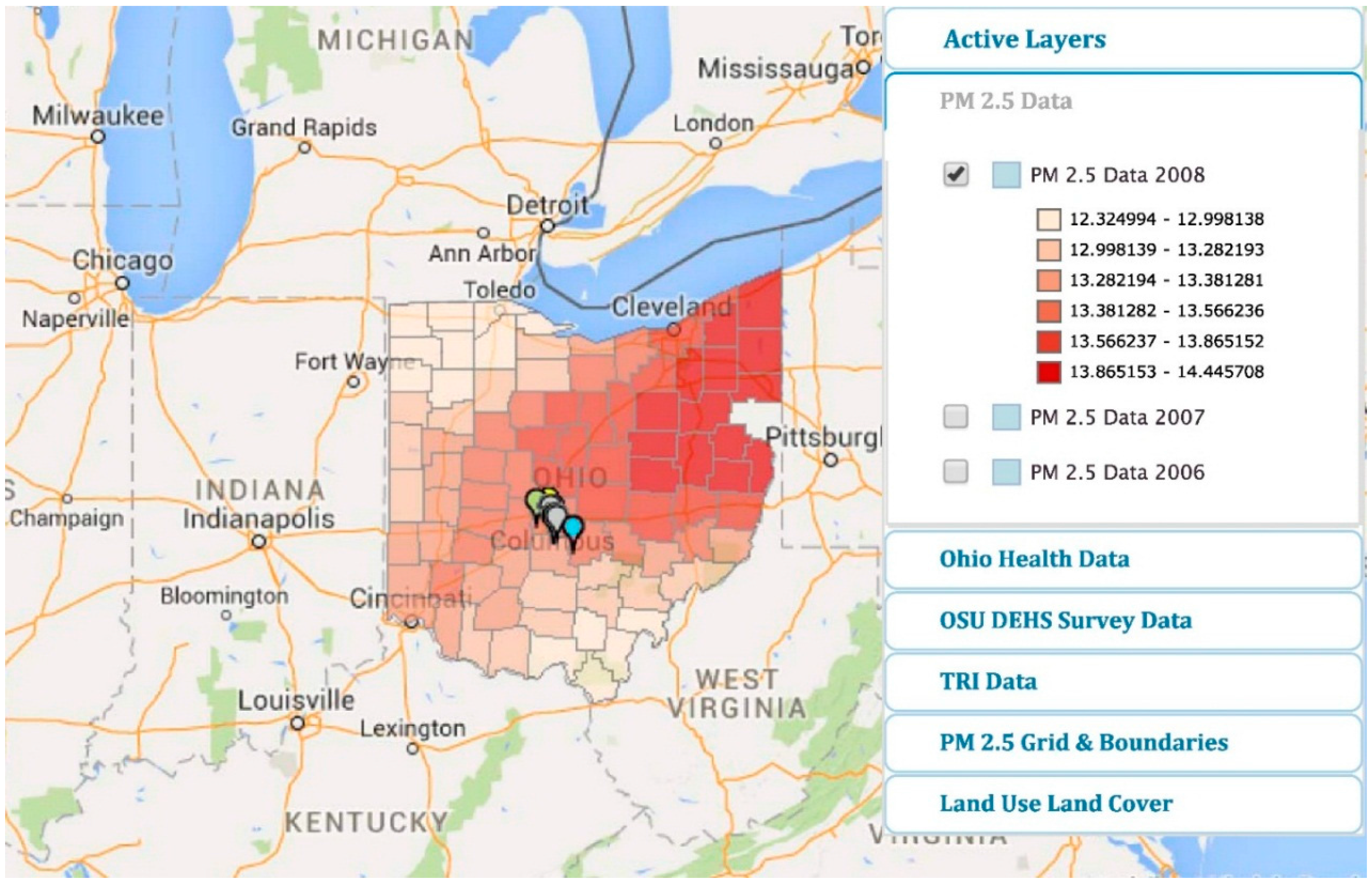

| Dataset | Type of Data | Partner Providing Access (or Publically Available) |
|---|---|---|
| Medicaid; Ohio Medicaid Assessment Survey | Claims data; insurance, access to care, health behaviors and experiences of care | Nationwide Children’s Hospital (NCH), Government Resource Center (GRC), Medicare & Medicaid Services |
| Pregnancy Risk Assessment Monitoring System (PRAMS) | Pre- and peri-natal risk and exposure data | Publicly available |
| USDA Food Environment Atlas | Access to affordable food, food security | Publicly available |
| U.S. Census | Socioeconomic data | Publicly available |
| NASA PM2.5 | Air quality data for all 88 Ohio counties | Marshall Space Flight Center |
| Birth and death certificates | Detailed birth outcomes data; can be linked | Ohio Department of Health |
| Tobacco retail outlet data | Exposure to tobacco advertising | Nielsen, County Auditors |
| Expression Genetics in Drug Therapy (XGEN) | Genome-wide data on disease phenotypes | OSU Center for Pharmacogenomics |
| Phenotypes and eXposures (PhenX) | Phenotype database | NIH |
| OH Longitudinal Data Archive | P-20 education data; housing data | OSU Center Human Resource Research |
| Adolescent Health & Development in Context | Socio-spatial study of child Adolescent health in Franklin Co | OSU Department Sociology |
| Epic Systems Corporation (EPIC) | Electronic health records | Wexner Medical Center, NCH |
| Toxics Release Inventory | Smokestack emissions into environment | Publicly available |
2.2. Consent for Soil Sampling
2.3. Soil Sampling Strategy

2.4. Statistical Analysis of Data
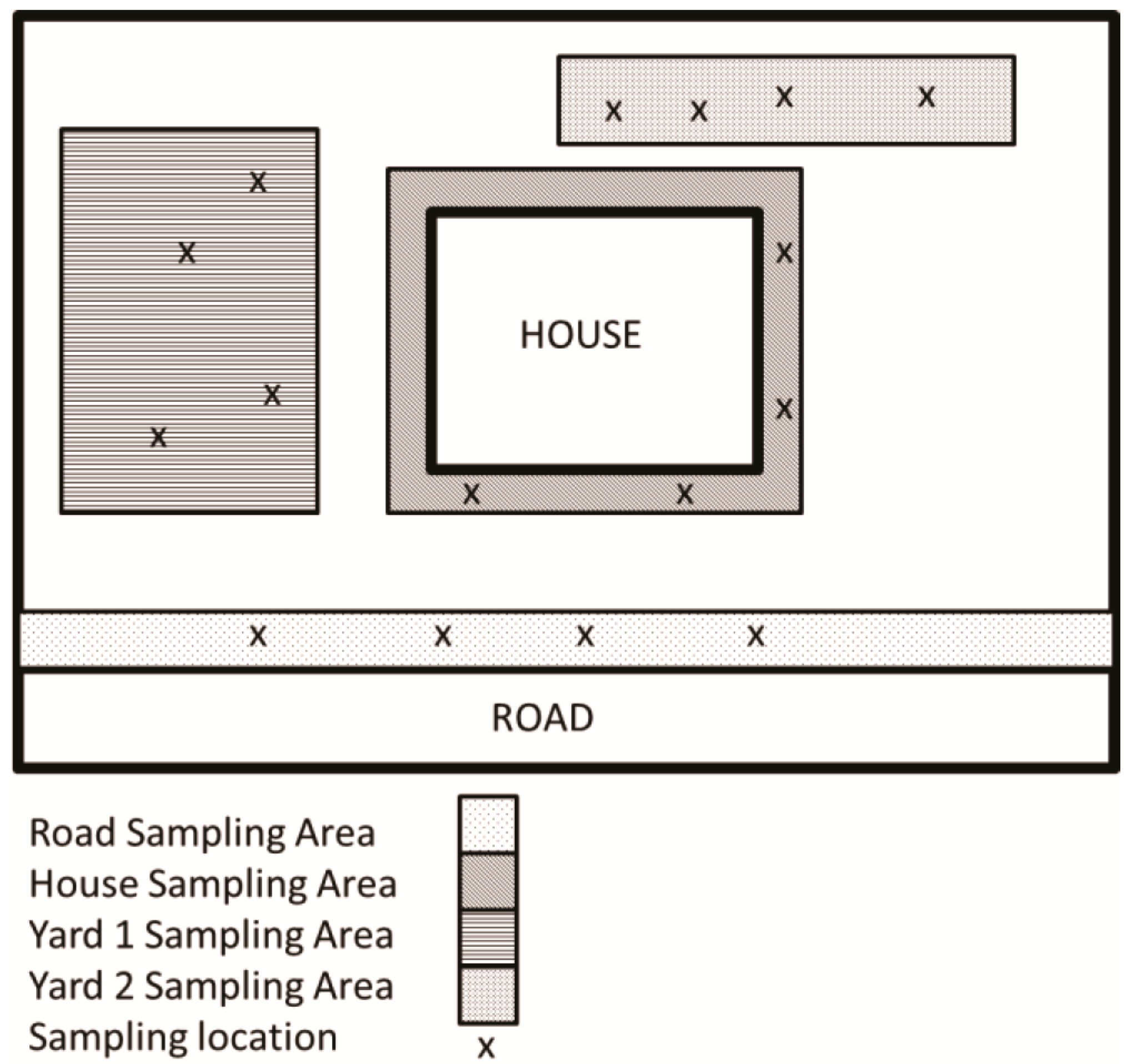
3. Results and Discussion
3.1. Data Mining for Historical Industrial Emissions in Close Proximity to SE
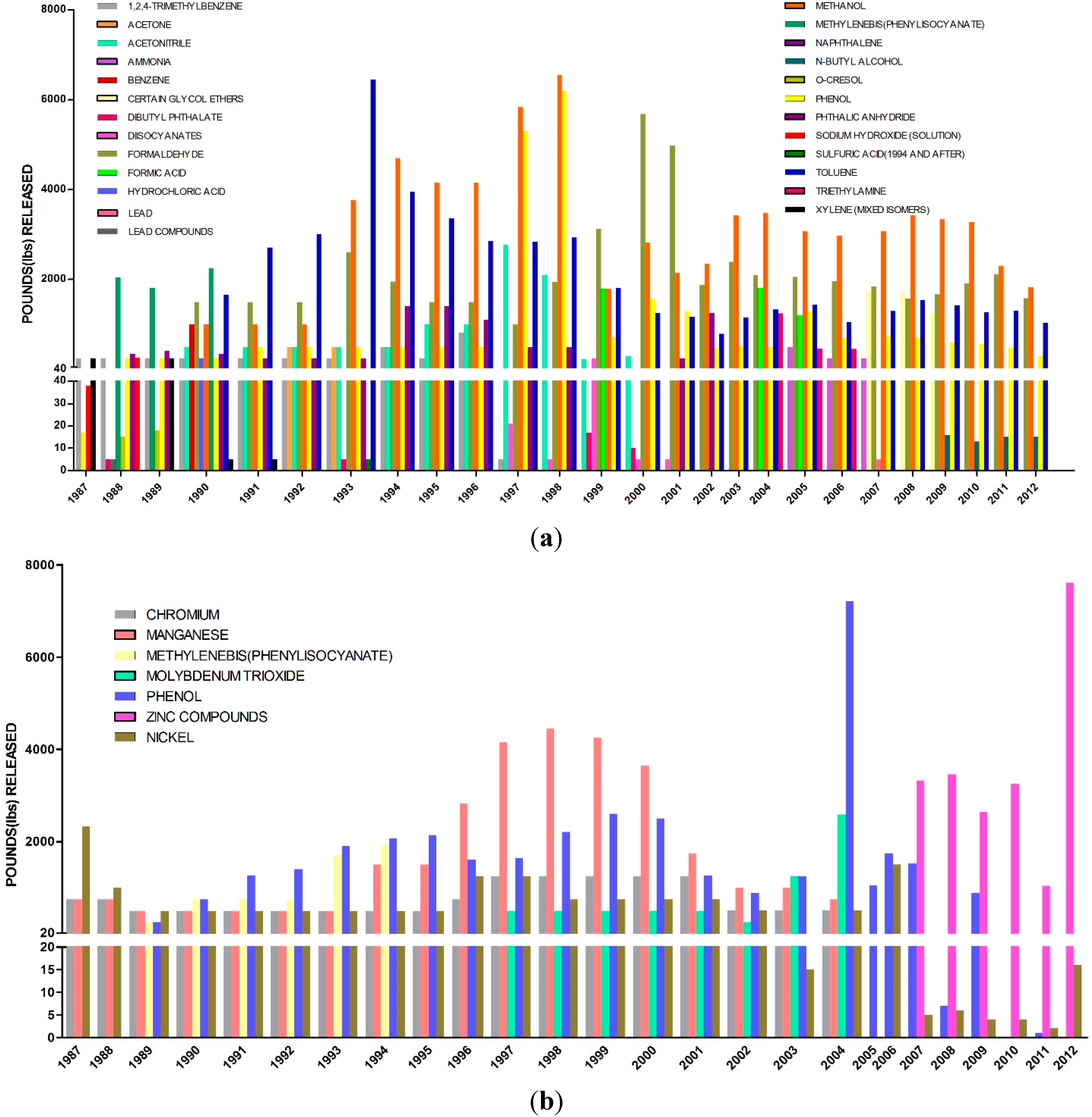
3.2. Soil Sampling Results in the SE Community
| Element | Mean ± 2 SE mg/kg | Upper Prediction Limits, mg/kg | Percent of Samples Exceeding Background 95th Percentile |
|---|---|---|---|
| All Samples (n = 84) | Published Values † | Percent ‡ | |
| Aluminum | 12,670 ± 532 | 50,540 3 | |
| Arsenic | 16 ± 1.0 | 20.7 2 | |
| Barium | 143 ± 10 | 443 3 | |
| Beryllium | <0.1 | 1.5 3 | |
| Cadmium | 1.6 ± 0.6 | 0.789 2 | 86% |
| Chromium | 30 ± 2 | 41.8 3 | |
| Cobalt | 10 ± 0.4 | 12.2 3 | |
| Copper | 38 ± 4 | 20.7 3 | 49% |
| Iron | 22,070 ± 580 | 39,098 1 | |
| Lead | 160 ± 48 | 41.5 2 | 99% |
| Magnesium | 7120 ± 640 | 9777 1 | |
| Manganese | 599 ± 28 | 765 1 | |
| Molybdenum | 7 ± 0.4 | 2.7 3 | 50% |
| Nickel | 29 ± 2 | 36.4 2 | |
| Phosphorus | 1050 ± 188 | 560 1 | 99% |
| Potassium | 4191 ± 196 | 16,657 3 | |
| Selenium | 2.7 ± 0.2 | 1.07 2 | 99% |
| Thallium | 0.7 ± 0.04 | 0.743 2 | 52% |
| Vanadium | 35 ± 2 | 66 3 | |
| Zinc | 262 ± 36 | 105 1 | 94% |
| Element | Sample Location Mean (mg/kg) ± SE ‡ | |||
|---|---|---|---|---|
| House | Road | Yard 1 | Yard 2 | |
| Aluminum | 12513 ± 438 a,‡ | 11400 ± 669 b | 13221± 523 a,b | 13530 ± 356 a,b |
| Arsenic | 17.2 ± 1.3 a | 13.8 ± 1.1 b | 15.7 ± 0.5 a,b | 15.9 ± 0.5 a,b |
| Barium | 160 ± 16.6 a | 136 ± 6.3 a | 139 ± 4.4 a | 138 ± 5.2 a |
| Beryllium | <0.1 a | <0.1 a | <0.1 a | <0.1 a |
| Cadmium | 2.9 ± 1.0 a | 1.1 ± 0.1 a | 1.2 ± 0.1 a | 1.3 ± 0.1 a |
| Chromium | 31.9 ± 3.3 a | 29.9 ± 2.5 a | 29.2 ± 1.6 a | 27.6 ± 0.8 a |
| Cobalt | 10.3 ± 0.3 a | 8.4 ± 0.4 b | 9.8 ± 0.3 a | 9.8 ± 0.3 a |
| Copper | 44.8 ± 4.2 a | 36.7 ± 3.8 a | 36.4 ± 1.6 a | 36.0 ± 1.9 a |
| Iron | 23,100 ± 504 a | 20,295 ± 638 b | 22,406 ± 540 a | 22,478 ± 473 a |
| Lead | 251 ± 88 a | 116 ± 15 a | 145 ± 21 a | 130 ± 19 a |
| Magnesium | 7672 ± 526 b | 9692 ± 648 a | 5493 ± 406 c | 5625 ± 494 c |
| Manganese | 629 ± 23.3 a | 549 ± 24.5 a | 619 ± 32 a | 599 ± 30 a |
| Molybdenum | 7.8 ± 0.4 a | 6.3 ± 0.3 b | 7.0 ± 0.3 a,b | 7.1 ± 0.2 a,b |
| Nickel | 30.4 ± 0.8 a | 28.6 ± 2.8 a | 28.2 ± 0.7 a | 28.4 ± 0.7 a |
| Phosphorus | 951 ± 92.0 a | 1216 ± 365.3 a | 1018 ± 40 a | 1014 ± 40 a |
| Potassium | 4088 ± 166 a | 4141 ± 237 a | 4161 ± 191 a | 4372 ± 191 a |
| Selenium | 2.8 ± 0.2 a | 2.6 ± 0.2 a | 2.9 ± 0.2 a | 2.7 ± 0.1 a |
| Thallium | 0.7 ± 0.0 a | 0.7 ± 0.04 a | 0.8 ± 0.1 a | 0.8 ± 0.0 a |
| Vanadium | 34.6 ± 1.0 a | 32.2 ± 1.5a | 36.0 ± 1.2 a | 36.4 ± 0.8 a |
| Zinc | 365 ± 57.0 a | 228 ± 27.7b | 230.4 ± 17.7 b | 225.4 ± 16.6 b |

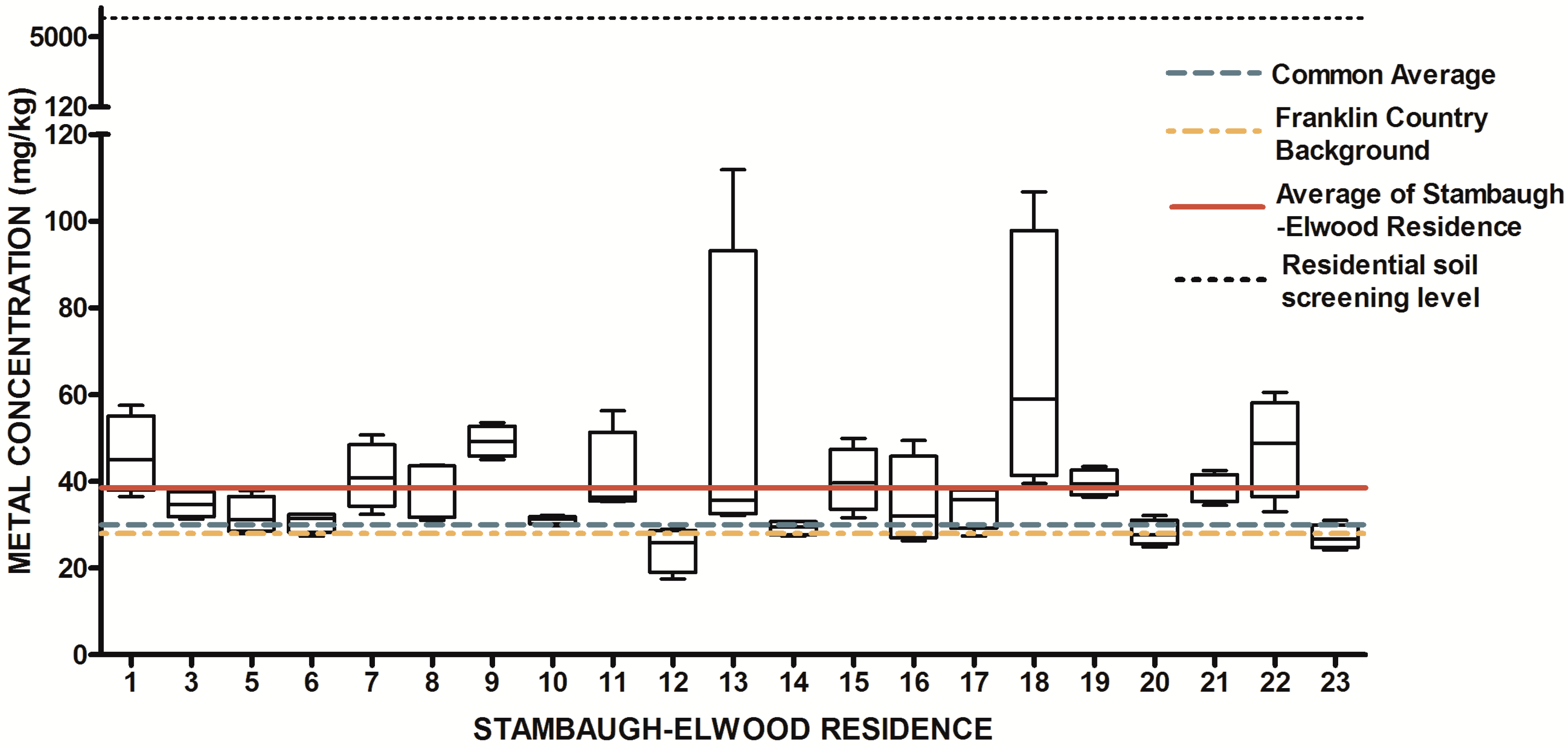
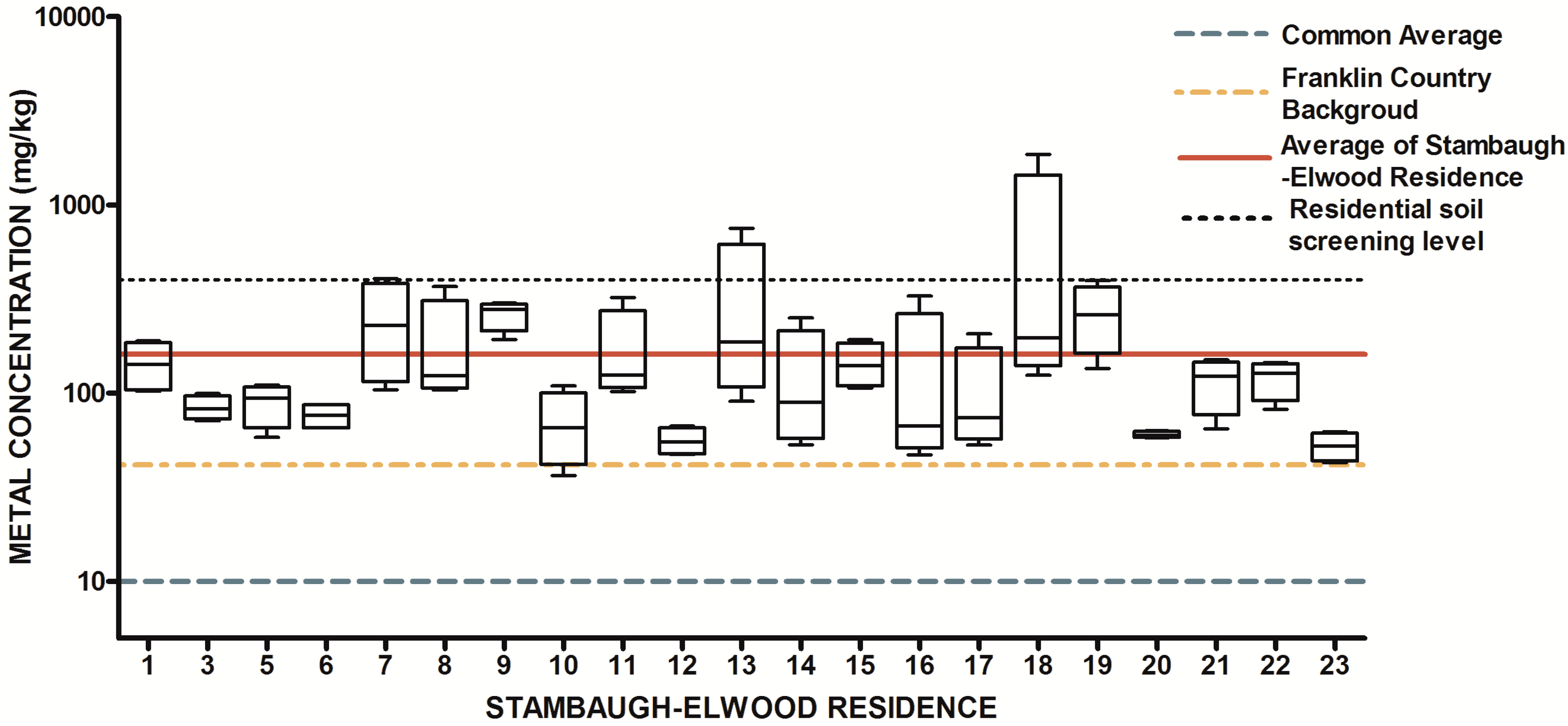
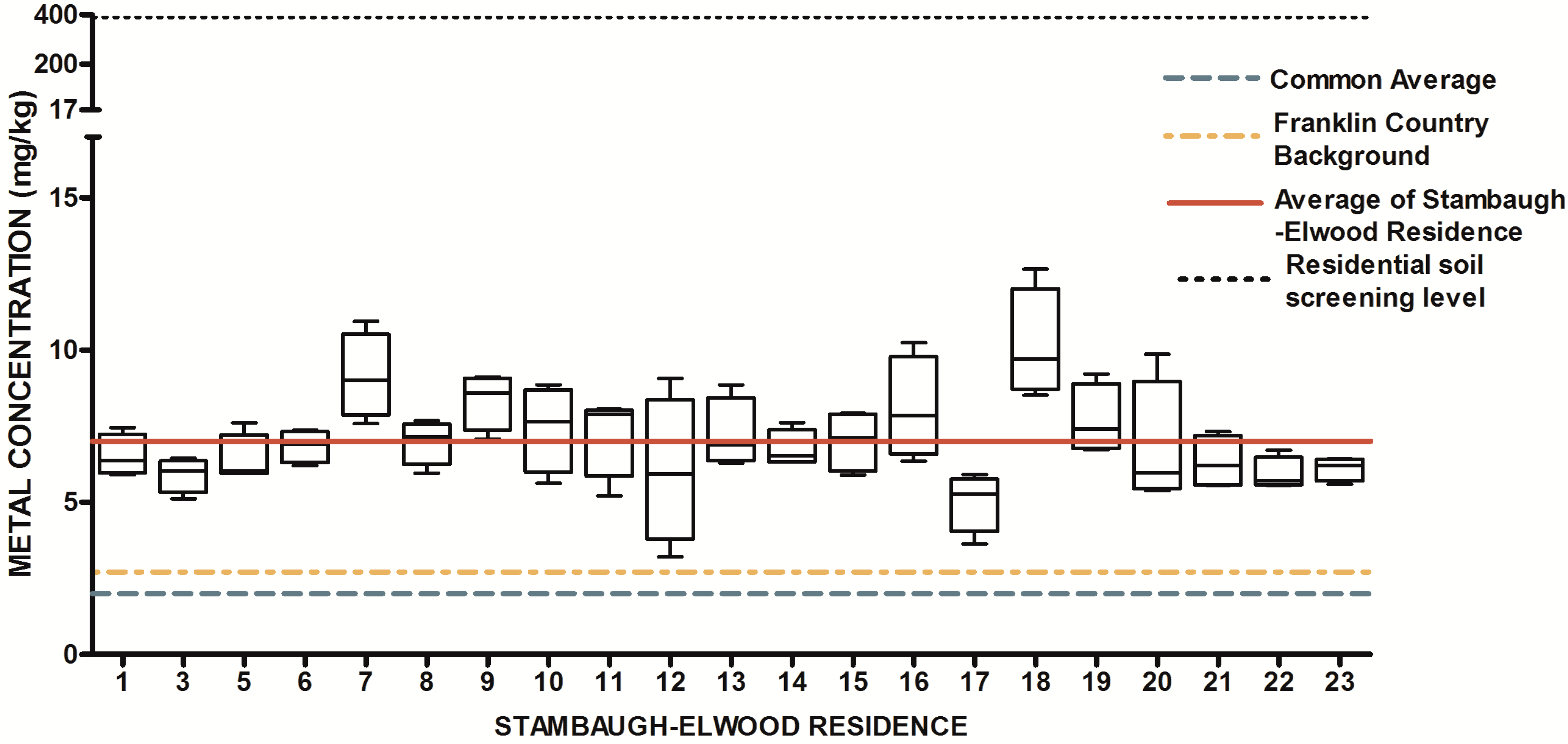
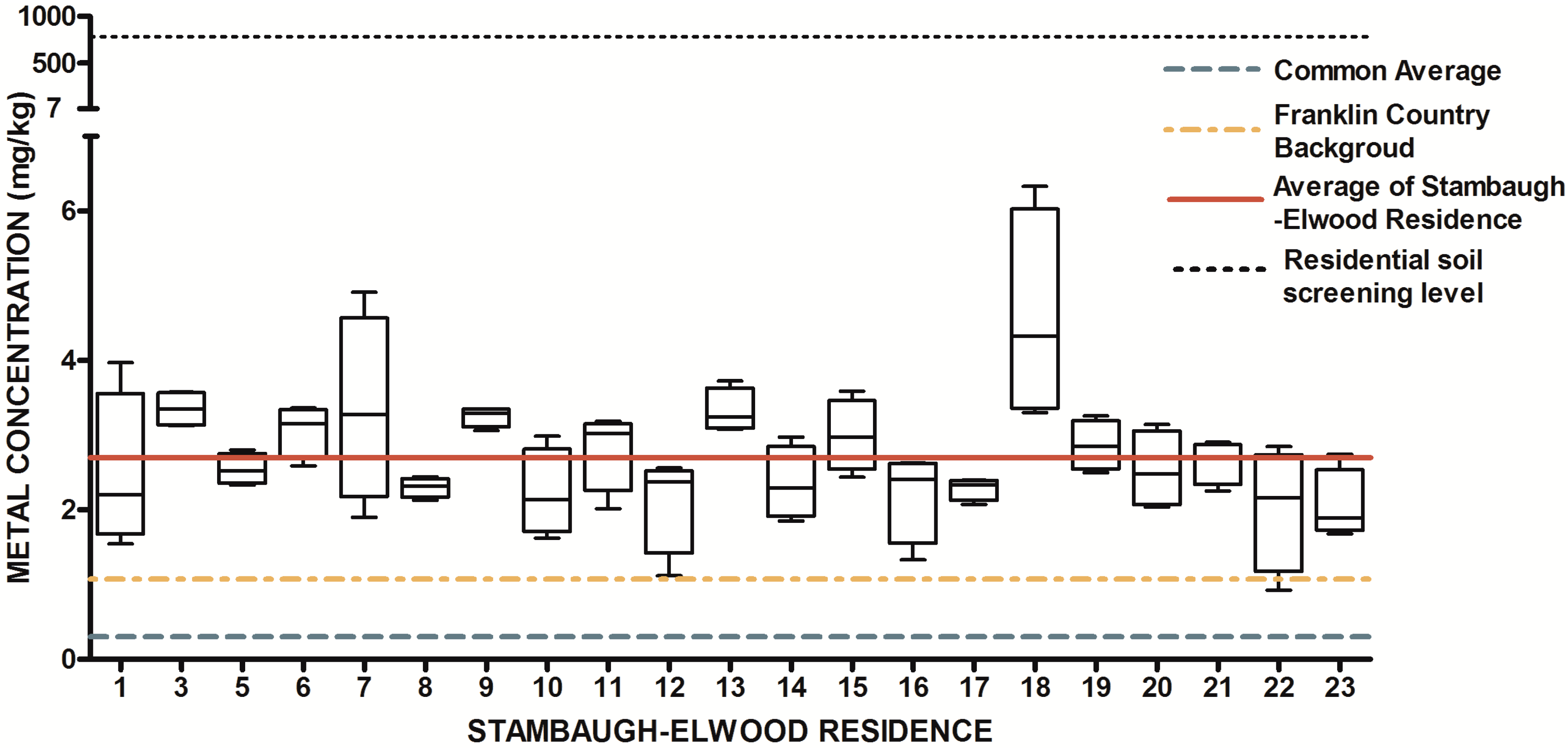
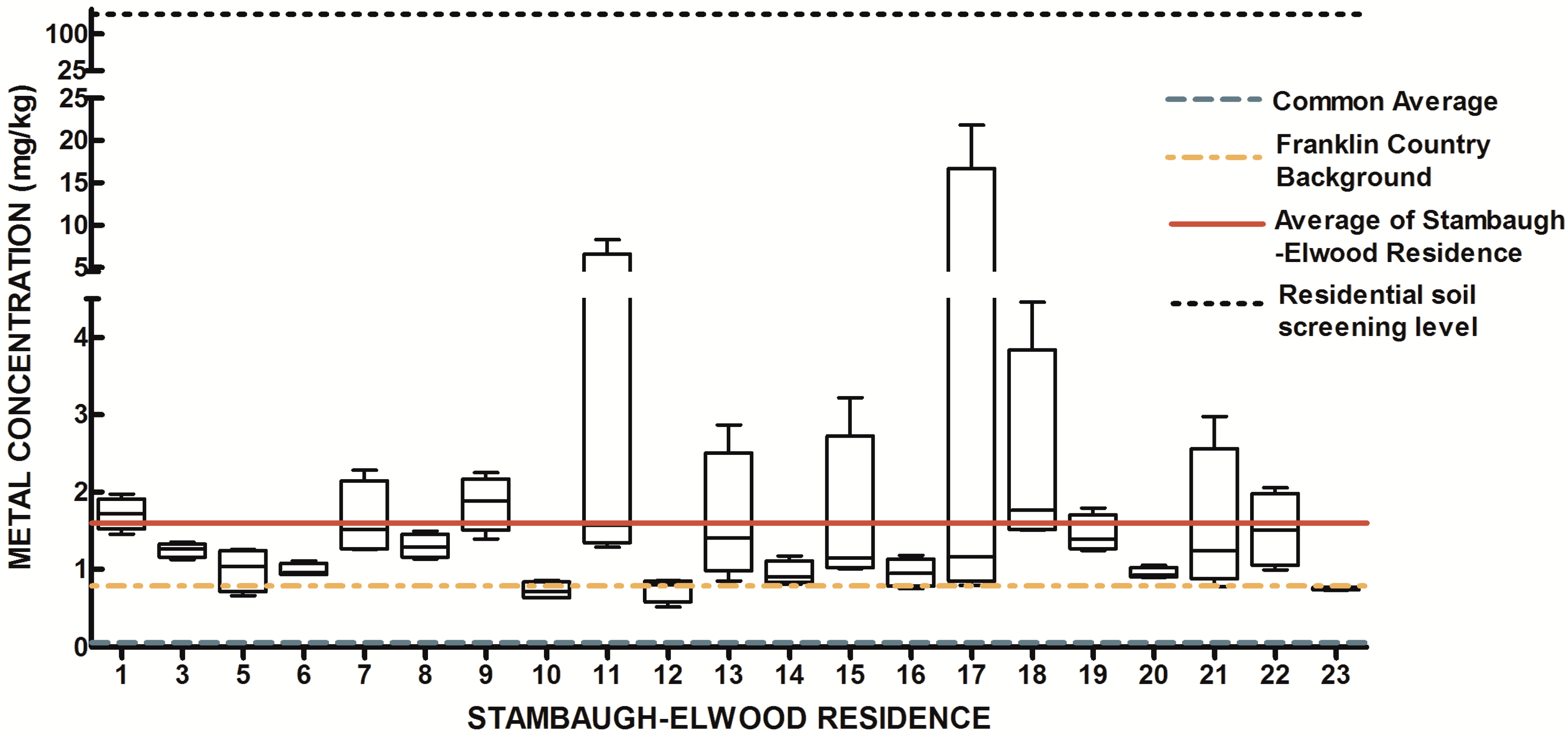
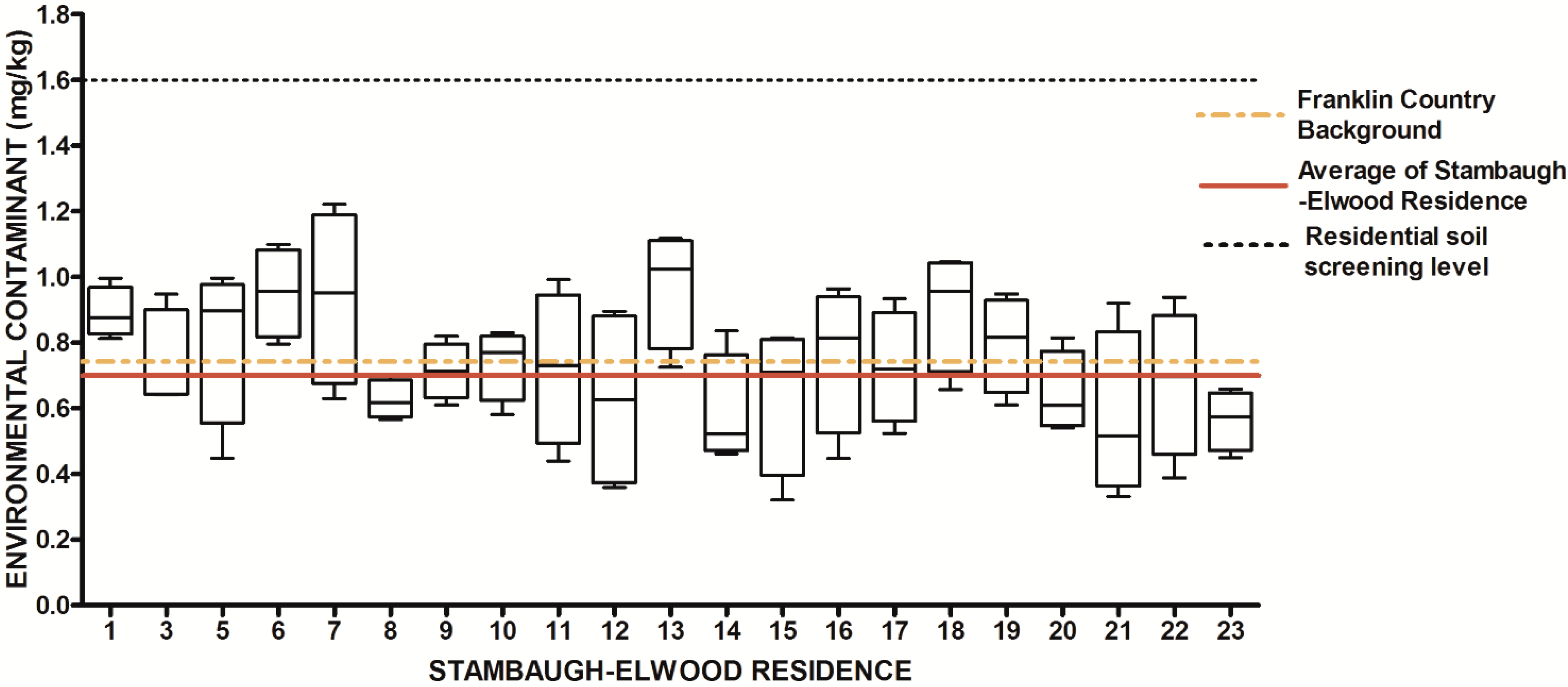
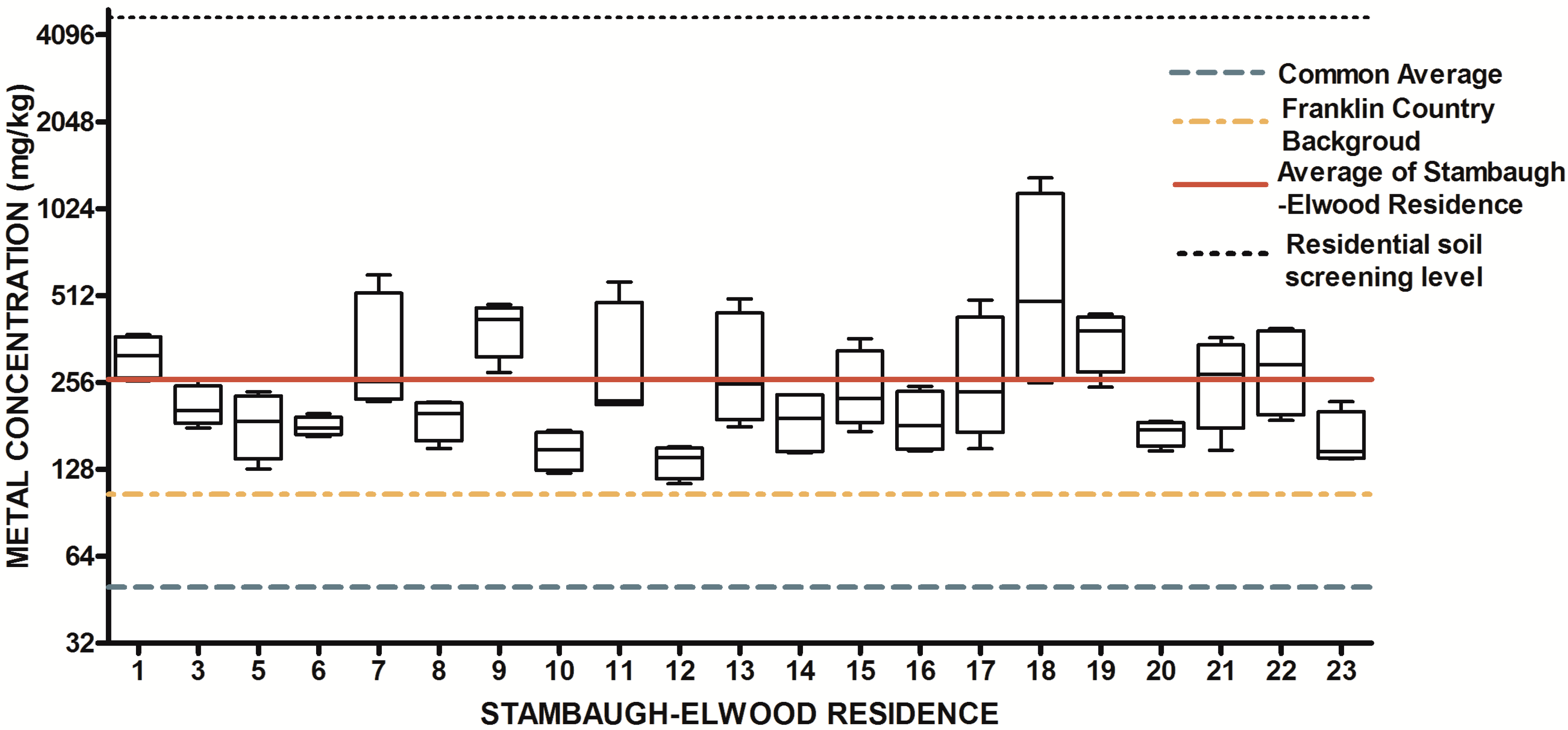
3.3. Citizen Science Risk Communication Activities
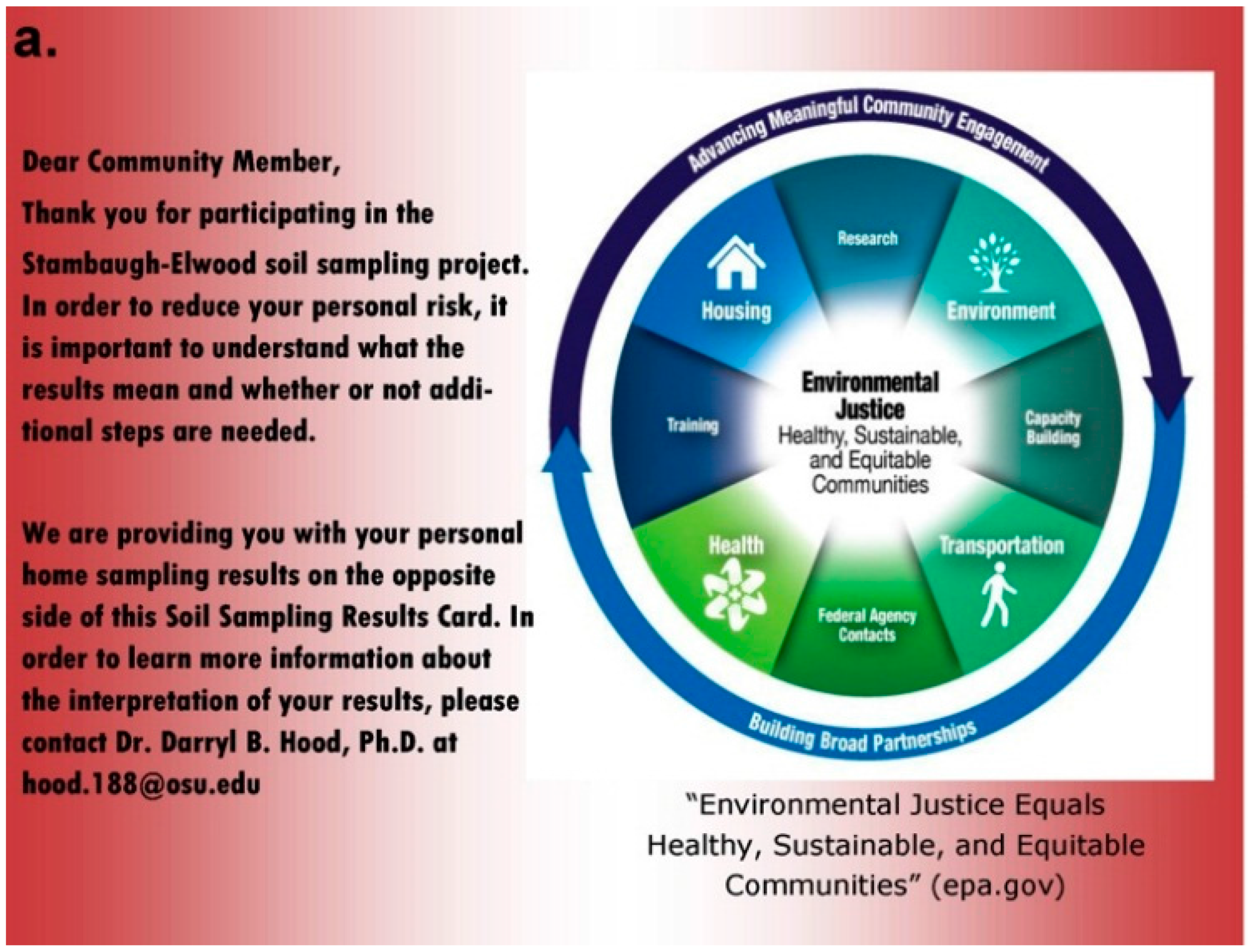
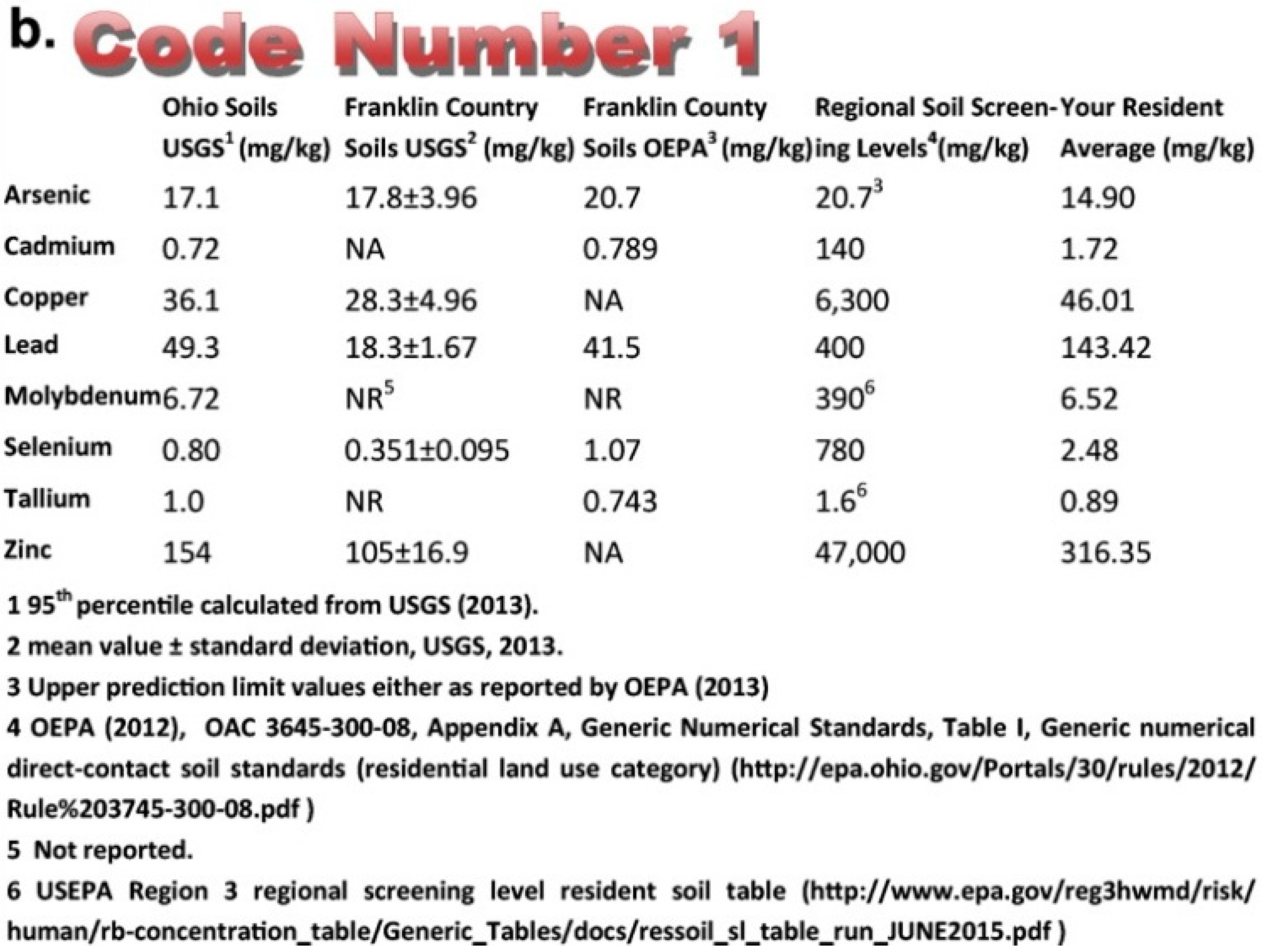
4. Conclusions
Acknowledgments
Author Contributions
Conflicts of Interest
References
- Juarez, P.D.; Matthews-Juarez, P.; Hood, D.B.; Im, W.; Levine, R.S.; Kilbourne, B.J.; Langston, M.A.; Al-Hamdan, M.Z.; Crosson, W.L.; Estes, M.G.; et al. The public health exposome: a population-based, exposure science approach to health disparities research. Int. J. Environ. Res. Public Health 2014, 11, 12866–12895. [Google Scholar] [PubMed]
- Office of Disease Prevention and Health Promotion. Healthy People 2020. Available online: http://www.healthypeople.gov/2020/topics-objectives/topic/environmental-health (accessed on 15 May 2015).
- Reece, J.; Norris, D. Place & Infant Health: “Hot Spot” and Asset Mapping for Infant and Maternal Health in Franklin County. Available online: http://gcinfantmortality.org/wp-content/uploads/2014/05/2014_05_20_GCIM_Reece_Norris_Presentation.pdf (accessed on 11 August 2015).
- Ramos, M.A.; Fox, A.; Simon, E.P.; Horowitz, C.R. A Community-academic partnership to address racial/ethnic health disparities through grant-making. Public Health Rep. 2013, 128, 61–67. [Google Scholar] [PubMed]
- Stuart, C.A. Public participation, technological discourses and the scale of gis. In Community Participation and Geographical Information Systems; CRC Press: New York, NY, USA, 2002. [Google Scholar]
- Kellogg, W.A. From the field: Observations on using gis to develop a neighborhood environmental information system for community-based organizations. Urisa J. 1999, 11, 15–32. [Google Scholar]
- GIS and Society: The Social Implications of How People, Space, and Environment Are Represented in GIS. Available online: http://eprints.cdlib.org/uc/item/9bw2d2rw (accessed on 11 August 2015).
- Kwan, M.-P. Gender differences in space-time constraints. Area 2000, 32, 145–156. [Google Scholar] [CrossRef]
- Burke, P.; Sawicki, D.S. The atlanta project: Reflections on ppgis practice. In Community Participation and Geographical Information Systems; Harris, T.M., Craig, W.J., Weiner, D., Eds.; CRC Press: New York, NY, USA, 2002; pp. 89–100. [Google Scholar]
- Poole, P. Indigenous Peoples, Mapping and Biodiversity Conservation: An Analysis of Current Activities and Opportunities for Applying Geomatics Technologies. Available online: http://rmportal.net/library/content/frame/indigenous-people.pdf/view (accessed on 11 August 2015).
- Drew, C.H. Transparency—Considerations for ppgis research and development. Urisa J. 2003, 15, 73–78. [Google Scholar]
- EPA. Environmental Justice. Draft EJ 2020 Action Agenda. Available online: http://www.epa.gov/environmentaljustice/ej2020/index.html (accessed on 15 June 2015).
- Collins, M.B. Risk-based targeting: Identifying disproportionalities in the sources and effects of industrial pollution. Am. J. Public Health 2011, 101, S231–S237. [Google Scholar] [CrossRef] [PubMed]
- Gochfeld, M.; Burger, J. Disproportionate exposures in environmental justice and other populations: The importance of outliers. Am. J. Public Health 2011, 101, S53–S63. [Google Scholar] [CrossRef] [PubMed]
- Morello-Frosch, R.; Zuk, M.; Jerrett, M.; Shamasunder, B.; Kyle, A.D. Understanding the cumulative impacts of inequalities in environmental health: Implications for policy. Health Affair. 2011, 30, 879–887. [Google Scholar] [CrossRef] [PubMed]
- Bullard, R.D.; Johnson, G.S. Environmentalism and public policy: Environmental justice: Grassroots activism and its impact on public policy decision making. J. Soc. Issues 2000, 56, 555–578. [Google Scholar] [CrossRef]
- Nweke, O.C.; Payne-Sturges, D.; Garcia, L.; Lee, C.; Zenick, H.; Grevatt, P.; Sanders, W.H.; Case, H.; Dankwa-Mullan, I. Symposium on integrating the science of environmental justice into decision-making at the environmental protection agency: An overview. Am. J. Public Health 2011, 101, S19–S26. [Google Scholar] [CrossRef] [PubMed]
- Tchounwou, P.; Yedjou, C.; Patlolla, A.; Sutton, D. Heavy Metal Toxicity and the Environment. In Molecular, Clinical and Environmental Toxicology; Luch, A., Ed.; Springer Basel: Berline, Germany, 2012; Volume 101, pp. 133–164. [Google Scholar]
- Greene, N.A.; White, J.D.; Morris, V.R.; Roberts, S.; Jones, K.L.; Warrick, C. Evidence for environmental contamination in residential neighborhoods surrounding the defense depot of memphis, tennessee. Int. J. Environ. Res. Public Health 2006, 3, 244–251. [Google Scholar] [CrossRef] [PubMed]
- Neeti, K.; Prakash, T. Effects of heavy metals during pregnancy. Int. Res. J. Environ. Sci. 2013, 2, 88–92. [Google Scholar]
- Jarup, L. Hazards of heavy metal contamination. Brit. Med. Bull. 2003, 68, 167–182. [Google Scholar] [CrossRef] [PubMed]
- EPA. Clean Air Act. Available online: http://www.epa.gov/air/caa/progress.html (accessed on 11 August 2015).
- Sharma, K. Assessment of Heavy Metal Contamination and Restoration of Soil Food Web Structural Complexity in Urban Vacant Lots in Two Post-Industrial Cities; The Ohio State University: Columbus, OH, USA, 2014. [Google Scholar]
- Sharma, K.; Basta, N.; Grewal, P. Soil heavy metal contamination in residential neighborhoods in post-industrial cities and its potential human exposure risk. Urban Ecosyst. 2015, 18, 115–132. [Google Scholar] [CrossRef]
- Langston, M.A.; Levine, R.S.; Kilbourne, B.J.; Rogers, G.L.; Kershenbaum, A.D.; Baktash, S.H.; Coughlin, S.S.; Saxton, A.M.; Agboto, V.K.; Hood, D.B.; et al. Scalable combinatorial tools for health disparities research. Int. J. Environ. Res. Public Health 2014, 11, 10419–10443. [Google Scholar] [CrossRef] [PubMed]
- Morales, L.S.; Lara, M.; Kington, R.S.; Valdez, R.O.; Escarce, J.J. Socioeconomic, cultural, and behavioral factors affecting hispanic health outcomes. J. Health Care Poor Underserved 2002, 13, 477–503. [Google Scholar] [CrossRef] [PubMed]
- Patricia, M.-J. Developing a cadre of transdisciplinary health disparities researchers for the 21st century. J. Health Care Poor Underserved 2013, 24, 121–128. [Google Scholar]
- Reece, J.; Olinger, J.; Holley, K. Social Capital and Equitable Neighborhood Revitalization on Columbus Southside. Available online: http://kirwaninstitute.osu.edu/wp-content/uploads/2014/10/201410-southside.pdf (accessed on 11 August 2015).
- Gray, S.C.; Edwards, S.E.; Schultz, B.D.; Miranda, M.L. Assessing the Impact of Race, Social Factors and Air Pollution on Birth Outcomes: A Population-Based Study. Available online: http://www.biomedcentral.com/content/pdf/1476-069X-13-4.pdf (accessed on 11 August 2015).
- Kruize, H.; Droomers, M.; van Kamp, I.; Ruijsbroek, A. What causes environmental inequalities and related health effects? An analysis of evolving concepts. Int. J. Environ. Res. Public Health 2014, 11, 5807–5827. [Google Scholar] [CrossRef] [PubMed]
- Krieger, N.; Waterman, P.D.; Gryparis, A.; Coull, B.A. Black carbon exposure, socioeconomic and racial/ethnic spatial polarization, and the Index of Concentration at the Extremes (ICE). Health Place 2015, 34, 215–228. [Google Scholar] [CrossRef] [PubMed]
- Massey, D.S. The prodigal paradigm returns: Ecology comes back to sociology. In Does It Take a Village? Community Effects on Children, Adolescents, and Families; Booth, A., Crouter, A.C., Eds.; Lawrence Erlbaum Associates: New Jersey, NJ, USA, 2001; p. 263. [Google Scholar]
- Grahame, T.J.; Klemm, R.; Schlesinger, R.B. Public health and components of particulate matter: The changing assessment of black carbon. J. Air Waste Manage. 2014, 64, 620–660. [Google Scholar] [CrossRef]
- Suglia, S.F.; Gryparis, A.; Wright, R.O.; Schwartz, J.; Wright, R.J. Association of black carbon with cognition among children in a prospective birth cohort study. Am. J. Epidemiol. 2008, 167, 280–286. [Google Scholar] [CrossRef] [PubMed]
- Juarez, P. Sequencing the public health genome. J. Health Care Poor Underserved 2013, 24, 114–120. [Google Scholar] [CrossRef] [PubMed]
- Pickett, K.; Pearl, M. Multilevel analyses of neighbourhood socioeconomic context and health outcomes: A critical review. J. Epidemiol. Community Health 2001, 55, 111–122. [Google Scholar] [CrossRef] [PubMed]
- Chen, C.-K.; Bruce, M.; Tyler, L.; Brown, C.; Garrett, A.; Goggins, S.; Lewis-Polite, B.; Weriwoh, M.L.; Juarez, P.D.; Hood, D.B.; et al. Analysis of an environmental exposure health questionnaire in a metropolitan minority population utilizing logistic regression and support vector machines. J. Health Care Poor Underserved 2013, 24, 153–171. [Google Scholar] [CrossRef] [PubMed]
- Stokes, S.C.; Hood, D.B.; Zokovitch, J.; Close, F.T. Blueprint for communicating risk and preventing environmental injustice. J. Health Care Poor Underserved 2010, 21, 35–52. [Google Scholar] [PubMed]
- Tyrrell, J.; Melzer, D.; Henley, W.; Galloway, T.S.; Osborne, N.J. Associations between socioeconomic status and environmental toxicant concentrations in adults in the USA: Nhanes 2001–2010. Environ. Int. 2013, 59, 328–335. [Google Scholar] [CrossRef] [PubMed]
- Evans, G.W.; Kim, P. Multiple risk exposure as a potential explanatory mechanism for the socioeconomic status—Health gradient. Ann. NY Acad. Sci. 2010, 1186, 174–189. [Google Scholar] [CrossRef] [PubMed]
- Mohai, P.; Lantz, P.M.; Morenoff, J.; House, J.S.; Mero, R.P. Racial and socioeconomic disparities in residential proximity to polluting industrial facilities: Evidence from the Americans’ Changing lives study. Am. J. Public Health 2009, 99, S649–S656. [Google Scholar] [CrossRef] [PubMed]
- Conley, D.; Strully, K.W. Birth weight, infant mortality, and race: Twin comparisons and genetic/environmental inputs. Soc. Sci. Med. 2012, 75, 2446–2454. [Google Scholar] [CrossRef] [PubMed]
- Brender, J.D.; Maantay, J.A.; Chakraborty, J. Residential proximity to environmental hazards and adverse health outcomes. Am. J. Public Health 2011, 10, S37–S52. [Google Scholar] [CrossRef] [PubMed]
- Ferguson, K.K.; O'Neill, M.S.; Meeker, J.D. Environmental contaminant exposures and preterm birth: A comprehensive review. J. Toxicol. Env. Heal. B 2013, 16, 69–113. [Google Scholar] [CrossRef] [PubMed]
- Greater Columbus Infant Mortality Task Force Final Report and Implementation Plan. Available online: http://gcinfantmortality.org/wp-content/uploads/2014/01/IMTF-2014-Final-Report-v10.pdf (accessed on 25 June 2014).
- Jiao, Y.; Darryl, B.H. Development of a Public Participatory Geographic Information Systems (PPGIS) Portal to Communicate Risk from Potential Exposure to Airborne Environmental Contaminants in a Vulnerable Columbus, OH Community. Master of Public Health Culminating Project Thesis, The Ohio State University, Ohio, OH, USA, May 2015. [Google Scholar]
- Roadmap to Revitalization: Southern Gateway Community Report. Available online: https://columbus.gov/uploadedFiles/Columbus/Departments/Development/Planning_Division/Document_Library/Library_Documents/PDFs/SG%20Community%20Report%202014.pdf (accessed on 25 June 2014).
- Community Health Advisory Committees. The City of Columbus Public Health Department. Available online: http://columbus.gov/publichealth/programs/health-advisory-committees/ (accessed on 11 August 2015).
- The Ohio State University, College of Public Health, Mappler: Interactive Map Stambaugh-Elwood Community. Available online: http://mappler.info/ohio/ (accessed on 11 August 2015).
- Community-Based Federal Environmental Justice Resource Guide. Available online: http://www3.epa.gov/environmentaljustice/resources/publications/interagency/resource-guide.pdf (accessed on 11 August 2015).
- EPA. EJSCREEN: Environmental Justice Screening and Mapping Tool. Available online: http://www2.epa.gov/ejscreen (accessed on 15 June 2015 ).
- EPA. Risk Management Plan (RMP) Rule. Available online: http://www2.epa.gov/rmp (accessed on 15 June 2015).
- Sieber, R. Public participation geographic information systems: A literature review and framework. Ann. Assoc. Am. Geogr. 2006, 96, 491–507. [Google Scholar] [CrossRef]
- Corburn, J. Environmental justice, local knowledge, and risk: the discourse of a community-based cumulative exposure assessment. Environ. Manage. 2002, 29, 451–466. [Google Scholar] [CrossRef] [PubMed]
- Al-Hamdan, M.Z.; Crosson, W.L.; Economou, S.A.; Estes, M.G., Jr.; Estes, S.M.; Hemmings, S.N.; Kent, S.T.; Puckett, M.; Quattrochi, D.A.; Rickman, D.L.; et al. Environmental public health applications using remotely sensed data. Geocarto Int. 2014, 29, 85–98. [Google Scholar] [CrossRef] [PubMed]
- Gonzalez, P.A.; Minkler, M.; Garcia, A.P.; Gordon, M.; Garzon, C.; Palaniappan, M.; Prakash, S.; Beveridge, B. Community-based participatory research and policy advocacy to reduce diesel exposure in West Oakland, California. Am. J. Public Health 2011, 101, S166–S175. [Google Scholar] [CrossRef] [PubMed]
- EPA. Method 3051a: Microwave Assisted Acid Digestion of Sediments, Sludges, Soils, and Oils. Available online: http://www.epa.gov/solidwaste/hazard/testmethods/sw846/pdfs/3051a.pdf (accessed on 11 August 2015).
- EPA. Method 1340: In Vitro Bioaccessibility Assay for Lead in Soil. Available online: http://www.epa.gov/solidwaste/hazard/testmethods/sw846/pdfs/1340.pdf (accessed on 20 May 2015).
- Ferenchik, M. Neighbors of South Side Factories Are Fed up with Toxic Waste. Available online: http://www.dispatch.com/content/stories/local/2015/05/11/neighbors-of-plant-are-fed-up.html (accessed on 11 August 2015).
- Hood, D.B.; Nayyar, T.; Ramesh, A.; Greenwood, M.; Inyang, F. Modulation in the developmental expression profile of sp1 subsequent to transplacental exposure of fetal rats to desorbed benzo[a]pyrene following maternal inhalation. Inhal. Toxicol. 2000, 12, 511–535. [Google Scholar] [PubMed]
- Hood, D.B.; Woods, L.; Brown, L.; Johnson, S.; Ebner, F.F. Gestational 2,3,7,8-tetrachlorodibenzo-p-dioxin exposure effects on sensory cortex function. Neurotoxicology 2006, 27, 1032–1042. [Google Scholar] [CrossRef] [PubMed]
- Wormley, D.D.; Chirwa, S.; Nayyar, T.; Wu, J.; Johnson, S.; Brown, L.A.; Harris, E.; Hood, D.B. Inhaled benzo[a]pyrene impairs long-term potentiation in the F1 generation rat dentate gyrus. Cell. Mol. Biol. 2004, 50, 715–721. [Google Scholar] [PubMed]
- Wormley, D.D.; Ramesh, A.; Hood, D.B. Environmental contaminant-mixture effects on CNS development, plasticity, and behavior. Toxicol. Appl. Pharmacol. 2004, 197, 49–65. [Google Scholar] [CrossRef] [PubMed]
- Wu, J.; Ramesh, A.; Nayyar, T.; Hood, D.B. Assessment of metabolites and Ahr and Cyp1a1 Mrna expression subsequent to prenatal exposure to inhaled benzo[a]pyrene. Int. J. Dev. Neurosci. 2003, 21, 333–346. [Google Scholar] [CrossRef]
- Li, Z.; Chadalapaka, G.; Ramesh, A.; Khoshbouei, H.; Maguire, M.; Safe, S.; Rhoades, R.E.; Clark, R.; Jules, G.; McCallister, M.; et al. Pah particles perturb prenatal processes and phenotypes: Protection from deficits in object discrimination afforded by dampening of brain oxidoreductase following in utero exposure to inhaled benzo[a]pyrene. Toxicol. Sci. 2012, 125, 233–247. [Google Scholar] [CrossRef] [PubMed]
- McCallister, M.M.; Maguire, M.; Ramesh, A.; Aimin, Q.; Liu, S.; Khoshbouei, H.; Aschner, M.; Ebner, F.F.; Hood, D.B. Prenatal exposure to benzo[a]pyrene impairs later-life cortical neuronal function. Neurotoxicology 2008, 29, 846–854. [Google Scholar] [CrossRef] [PubMed]
- Brown, L.A.; Khousbouei, H.; Goodwin, J.S.; Irvin-Wilson, C.V.; Ramesh, A.; Sheng, L.; McCallister, M.M.; Jiang, G.C.; Aschner, M.; Hood, D.B. Down-regulation of early ionotrophic glutamate receptor subunit developmental expression as a mechanism for observed plasticity deficits following gestational exposure to benzo[a]pyrene. Neurotoxicology 2007, 28, 965–978. [Google Scholar] [CrossRef] [PubMed]
- Sheng, L.; Ding, X.; Ferguson, M.; McCallister, M.; Rhoades, R.; Maguire, M.; Ramesh, A.; Aschner, M.; Campbell, D.; Levitt, P.; et al. Prenatal polycyclic aromatic hydrocarbon exposure leads to behavioral deficits and downregulation of receptor tyrosine kinase, MET. Toxicol. Sci. 2010, 118, 625–634. [Google Scholar] [CrossRef] [PubMed]
- Lindsay, W.L. Chemical Equilibria in Soils; John Wiley and Sons Ltd.: Chichester, UK, 1979. [Google Scholar]
- Kasich, J.; Taylor, M.; Nally, S.J. Evaluation of Background Metal Soil Concentrations in Franklin County—Columbus Area; OEPA: Columbus, OH, USA, 2013; p. 132. [Google Scholar]
- USGS. National Geochemical Survey. Mineral Resources on-Line Spatial Data. Available online: http://mrdata.usgs.gov/geochem/doc/averages/countydata.htm (accessed on 29 May 2015).
- USGS. Geochemical and Mineralogical Data for Soils of the Conterminous United States. Available online: http://pubs.usgs.gov/ds/801/ (accessed on 29 May 2015).
- Mielke, H.W.; Powell, E.T.; Shah, A.; Gonzales, C.R.; Mielke, P.W. Multiple metal contamination from house paints: Consequences of power sanding and paint scraping in New Orleans. Environ. Health Persp. 2001, 109, 973–978. [Google Scholar] [CrossRef]
- Minca, K.K.; Basta, N.T.; Scheckel, K.G. Using the mehlich-3 soil test as an inexpensive screening tool to estimate total and bioaccessible lead in urban soils. J. Environ. Qual. 2013, 42, 1518–1526. [Google Scholar] [CrossRef] [PubMed]
- Turner, A.; Sogo, Y.S. Concentrations and bioaccessibilities of metals in exterior urban paints. Chemosphere 2012, 86, 614–618. [Google Scholar] [CrossRef] [PubMed]
- Lee, L.M.; Teutsch, S.M.; Churchill, R.E. Principles and Practice of Public Health Surveillance; Oxford University Press: Oxford, UK, 2000. [Google Scholar]
- Taylor, D.E. The Rise of the environmental justice paradigm: Injustice framing and the social construction of environmental discourses. Am. Behav. Sci. 2000, 43, 508–580. [Google Scholar] [CrossRef]
- Bonney, R.; Ballard, H.; Jordan, R.; McCallie, E.; Phillips, T.; Shirk, J.; Wilderman, C.C. Public Participation in Scientific Research: Defining the Field and Assessing Its Potential for Informal Science Education. A Caise Inquiry Group Report. Available online: http://eric.ed.gov/?id=ED519688 (accessed on 11 August 2015).
- Brossard, D.; Lewenstein, B.; Bonney, R. Scientific knowledge and attitude change: The impact of a citizen science project. Int. J. Sc. Educ. 2005, 27, 1099–1121. [Google Scholar] [CrossRef]
- Evans, C.; Abrams, E.; Reitsma, R.; Roux, K.; Salmonsen, L.; Marra, P.P. The neighborhood nestwatch program: Participant outcomes of a citizen-science ecological research project. Conserva. Biol. 2005, 19, 589–594. [Google Scholar] [CrossRef]
- Falk, J.H.; Storksdieck, M.; Dierking, L.D. Investigating public science interest and understanding: Evidence for the importance of free-choice learning. Public Underst. Sci. 2007, 16, 455–469. [Google Scholar] [CrossRef]
- Brown, P. Popular epidemiology and toxic waste contamination: Lay and professional ways of knowing. J. Health Soc. Behav. 1992, 33, 267–281. [Google Scholar] [CrossRef] [PubMed]
- Corburn, J. Street Science: Community Knowledge and Environmental Health Justice; MIT Press: Cambridge, MA, USA, 2005. [Google Scholar]
- Wilson, S.; Campbell, D.; Dalemarre, L.; Fraser-Rahim, H.; Williams, E. A critical review of an authentic and transformative environmental justice and health community—University partnership. Int. J. Environ. Res. Public Health 2014, 11, 12817. [Google Scholar] [CrossRef] [PubMed]
- Schwartz, J.; Bellinger, D.; Glass, T. Expanding the scope of environmental risk assessment to better include differential vulnerability and susceptibility. Am. J. Public Health 2011, 101, S88–S93. [Google Scholar] [CrossRef] [PubMed]
- Sadana, R.; Blas, E. What can public health programs do to improve health equity? Public Health Rep. 2013, 128, 12–20. [Google Scholar] [PubMed]
© 2015 by the authors; licensee MDPI, Basel, Switzerland. This article is an open access article distributed under the terms and conditions of the Creative Commons by Attribution (CC-BY) license (http://creativecommons.org/licenses/by/4.0/).
Share and Cite
Jiao, Y.; Bower, J.K.; Im, W.; Basta, N.; Obrycki, J.; Al-Hamdan, M.Z.; Wilder, A.; Bollinger, C.E.; Zhang, T.; Hatten, L.S.; et al. Application of Citizen Science Risk Communication Tools in a Vulnerable Urban Community. Int. J. Environ. Res. Public Health 2016, 13, 11. https://doi.org/10.3390/ijerph13010011
Jiao Y, Bower JK, Im W, Basta N, Obrycki J, Al-Hamdan MZ, Wilder A, Bollinger CE, Zhang T, Hatten LS, et al. Application of Citizen Science Risk Communication Tools in a Vulnerable Urban Community. International Journal of Environmental Research and Public Health. 2016; 13(1):11. https://doi.org/10.3390/ijerph13010011
Chicago/Turabian StyleJiao, Yuqin, Julie K. Bower, Wansoo Im, Nicholas Basta, John Obrycki, Mohammad Z. Al-Hamdan, Allison Wilder, Claire E. Bollinger, Tongwen Zhang, Luddie Sr. Hatten, and et al. 2016. "Application of Citizen Science Risk Communication Tools in a Vulnerable Urban Community" International Journal of Environmental Research and Public Health 13, no. 1: 11. https://doi.org/10.3390/ijerph13010011
APA StyleJiao, Y., Bower, J. K., Im, W., Basta, N., Obrycki, J., Al-Hamdan, M. Z., Wilder, A., Bollinger, C. E., Zhang, T., Hatten, L. S., Hatten, J., & Hood, D. B. (2016). Application of Citizen Science Risk Communication Tools in a Vulnerable Urban Community. International Journal of Environmental Research and Public Health, 13(1), 11. https://doi.org/10.3390/ijerph13010011






